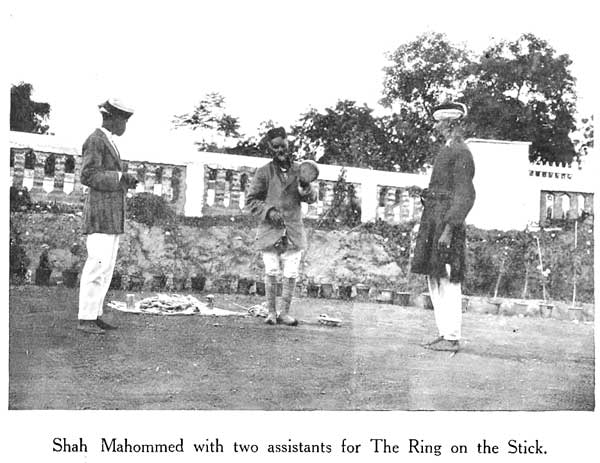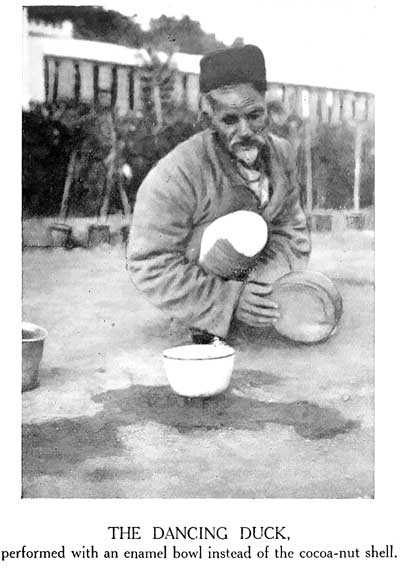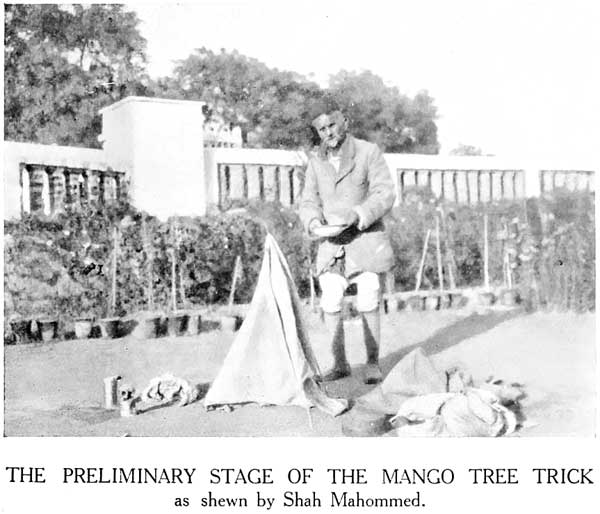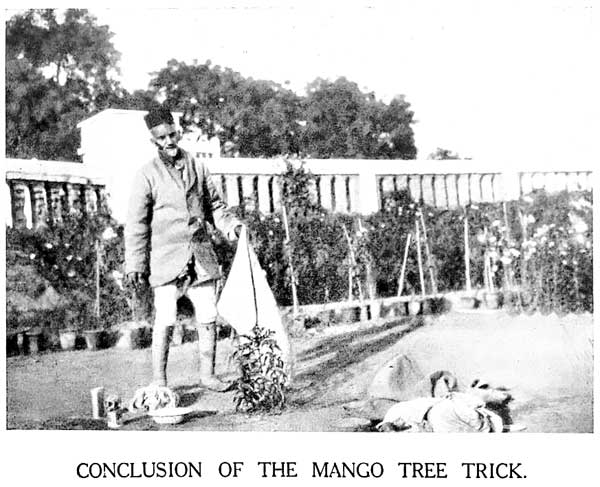.

INDIAN CONJURING
BY
MAJOR L. H. BRANSON M.I.M.C.
Indian Army
With 8 Illustrations
LONDON
GEORGE ROUTLEDGE & SONS LTD.
NEW YORK: E. P. DUTTON & CO.
I dedicate this small volume to
MY WIFE
who has always been my best audience and my keenest critic
at the innumerable sleight-of-hand performances that I have
had the pleasure of giving in her presence.
the TIMES OF INDIA, ILLUSTRATED WEEKLY, by whose kind permission
they are reprinted.
CONTENTS
| CHAPTER | PAGE | ||
| I. | A COMPARISON | 1 | |
| II. | THE CUP AND BALLS | 16 | |
| III. | THE BAMBOO-STICKS | 23 | |
| THE RING ON THE STICK | 26 | ||
| IV. | THE GLASS BOX | 32 | |
| THE BUNDER BOAT | 35 | ||
| V. | THE BOWL OF RICE | 39 | |
| THE COLOURED SANDS | 42 | ||
| VI. | A ROPE TRICK | 46 | |
| THE SWASTIKA | 49 | ||
| THE EGG BAG | 52 | ||
| VII. | THE DANCING DUCK | 54 | |
| THE MANGO TREE TRICK | 57 | ||
| VIII. | THE BASKET TRICK | 65 | |
| IX. | THE INDIAN ROPE TRICK | 76 | |
| X. | SNAKES AND CROCODILES | 89 | |
| XI. | GENERALITIES AND OTHER MYTHS | 98 |
LIST OF ILLUSTRATIONS
INDIAN CONJURING
CHAPTER I
A COMPARISON
Since the world began Magic and wizardy seem to have held a great fascination for mankind, an example being in the story of the Witch of Endor. That this tendency has in no wise altered is clear from the popularity of conjurors, illusionists, and so called magicians who still, be it East or West, attract an audience so easily and so surely. This little volume is written in the hopes that it may prove of interest to the thousands who reside in India, and those other thousands who,[2] visiting its coral shores from time to time, often discuss in wondering amazement how the Indian conjuror performs his tricks. It is also written to uphold the reputation of the Western conjuror against the spurious ascendancy held by his Eastern confrere.
Before describing the many well known tricks that are shewn by the "house to house" Jadoo-wallah, and explaining how they are done, we will compare the average Indian conjuror with his mystic friends in Europe, America and China.
Let us for a moment picture in our mind's eye the stage and person of the European or American conjuror. A few small tables with spindle legs (upon them a steel frame or so, transparent and decorative) are exposed to our view. The performer appears with rolled up sleeves in close fitting clothes and by the end of his performance has filled the stage with[3] several large flags, a bouquet of flowers and, may be, a beautiful lady, all, possibly produced from a top hat. His performance is given to the accompaniment of amusing patter and is brightened with the colour of the articles he produces.
He may be an illusionist pure and simple and does not indulge in sleight-of-hand at all. In this case the comparison with the Indian Jadoo-wallah is not a fair one, as the latter has not the means to purchase the complicated mechanism necessary for up-to-date illusions as shewn by European magicians.
Whether or no his superior education is the reason, the European conjuror gains in skill and shows his inventive genius as time goes on. His effects are studied, and his paraphernalia embraces more and more varied articles. The disappearance of a Christmas tree with all its candles lighted is an excellent example to what[4] he has risen. He takes an interest in his profession or calling and strives to outdo others in neatness or by inventing an exclusive trick to which his name can be given and handed down to posterity. This may be the result of large fees that can be earned at the "Halls" or by private entertainments by those at the top of the tree. But these fees are open to a conjuror of any nationality, and I am confident that the interest the European takes in his hobby has more to do with his superiority than education and large fees. The ruling Princes of India are very fond of watching a clever conjuror and can pay enormous fees, but no Indian conjuror appears to appeal to them. A Western performer always wants to give his best to his audience and takes a pride in mystifying them. David Devant, who is one of the greatest living exponents has quite recently written an article in the[5] Strand Magazine of his dreams of tricks that he would like to be able to do. To meet the late Charles Bertram "at home" was a study in itself. To have seen him playing, as a child would play, with a pack of cards until he stumbled across a new sleight and watched the enjoyment written all over his face, was a proof of his deep interest in his hobby.
Can anyone imagine an Indian conjuror dreaming of a new trick? "Ghee and khana" (clarified butter and food) form the subject of the majority of his dreams. When he does play with anything it is to caress lovingly the "paisa" or pieces of money that he last earned, not to improve his dexterity but because they will give him a good meal, a cup of arak, (or intoxicating liquor) and a long lazy sleep.
The Chinaman gives his entertainment with his stage well filled with tables covered with gorgeous dragon-be-decked draperies[6] that reach the ground, and behind which useful assistants could be easily concealed. His own garments are roomy and his sleeves could contain a multitude of billiard balls and rabbits. But he gives a showy performance with clean bright articles, ending up occasionally, as I have seen, with the production of twelve large Chinese lanterns all lit!
The Chinaman is the inventor of many of the most beautiful illusions that are performed. One of the prettiest tricks imaginable is that of the production of bowls of gold fish in real water, one of Chinese origin. He has improved from ancient times as an up-to-date showman, and is a wonderful illusionist. To show what can be done in the voluminous garments of a Chinaman, on one occasion, I, in his national costume, produced a large bowl of water which took two men to carry away, then a little boy aged ten, and his[7] younger brother aged five, ostensibly from a shawl without moving from the centre of a stage devoid of trap doors, or any furniture. It was more a feat of strength than skill at conjuring, though, as one may readily imagine, extremely effective.
The Chinaman is also a clever productionist and excels in producing flowers, lanterns and similar articles. His dexterity or sleight-of-hand is good but inferior to that of the European. He has and uses well, many extremely ingenious devices, or "fakes." One in particular has always appealed to me and is worth describing. He takes a piece of tissue paper which he either chews, or moistens somehow and rolls it into a small ball like pulp. This he places on his fan and tosses up into the air several times while it gradually assumes the shape of an egg. After some few seconds it has become a large duck's egg which he places[8] in an egg cup on the table in full view of the audience. This little trick is very effective, easy to do, and can be purchased for half-a-crown at any magical depot in London.
I hope that I have gained my point in showing that the Chinaman is an ingenious and a neat performer. There are many other amazing tricks which were originated in China and the far East, (as the Japanese are as good, if not better than the Chinese) but this egg trick is to my mind the most symbolical of Chinese magic.
The Indian juggler or Jadoo-wallah arrives with a basket large enough to contain a man, as we will see later, a huge dilapidated bag, a voluminous dhotie or loin cloth, and possibly a snake basket or two. He is a poor man or "gareeb admi" and looks it. He starts a whine in the hope of getting an audience through sympathy. If he does not whine he assumes[9] an air of superiority that is somewhat exasperating. At sleight-of-hand he is far below the level of the average European performer. He spoils his art by the continual diving into his bag ostentatiously to dig out the bone of a cow or an antiquated "dolly," of the rag doll type. If only he would do his little tricks away from his impedimenta in clean clothes he would add 50% to the merit of his performance though it would probably be not so entertaining to those newly arrived in India.
I have very little praise to give to the Indian conjuror as an artist, either in sleight-of-hand, in juggling, or as an illusionist. His tricks are as "old as my unpaid bills" and from time immemorial have been performed with the same monotonous patter and the irritating drone of the "bean" or so called musical instrument. I may here say that this[10] musical torture is used to disguise movements of the showman's hand in the same way as the European uses his magic wand, an instrument that does not appeal to me at all, though at times very useful.
The articles used by the Indian conjuror are very very primitive and of indifferent manufacture. The Jadoo-wallah has remained as he was 50, 60, or 100 years ago. The old gentleman whose portrait forms the first illustration of this book told me that the tricks he does were learnt by his great grandfather from a friend in Lahore. This takes us back some 150 years. The tricks have remained the same as when taught at Lahore though my old friend has brought them up-to-date by singing "Ta-ra-ra-boom-de-ay" between each experiment!
The Indian conjuror has never indulged in pure sleight-of-hand to any extent, and has never improved upon any of his illusions.
He seldom has any patter worth listening to and that which he uses consists usually of "Beggie, beggie, aow" or "Beggie beggie jaow." "Bun, two, three, four, five, white, bite, fight, kite." Amusing to a casual observer but hopeless from an artists point of view.
Latterly some Indian conjurors have attempted to give in India performances on European lines. They have purchased the necessary paraphernalia from London and have as much idea of using it to its best advantage as a crocodile has of arranging the flowers on a dinner table. Our Indian Jadoo-wallah usually gets himself into a very tight fitting third or fourth hand evening dress on these occasions, to show, I presume, how European he is. The audience is more concerned with the possibility of its bursting and their having to leave the theatre for decency's sake than they are of the feats he is attempting to imitate.[12]
His patter is excruciating and, to hide his want of skill in sleight-of-hand, he moves his hands and arms in grotesque curves, with his body so bent that it is almost impossible to see what he is trying to do. I have never yet seen any Indian give an English performance that would be tolerated on the sands at Slushton-on-Sea the seat of my ancestral home. While writing the above I have in mind one of these Indians, an impossible person, who, as Court performer to several of the Ruling Indian Princes, makes the astonishing total of Rs. 1200 or £80 a month.
The only native conjurors that I have seen who are consistently good at sleight-of-hand, (and they are Arabs or Egyptians) are the invaders of the ships at Port Said, and their one and only good point, magically, is their manipulation of those unfortunate chickens. Their "Gillie, gillie, Mrs. Langtry" is more up-to-date[13] and an improvement upon the "Beggie, beggie, aow" of India.
It has always been a marvel to me how the Indian conjuror has gained his spurious reputation. I can only ascribe the fact to the idea that the audience start with the impression, sub-conscious though it may be—of Mahatmaism, Jadoo, or any other synonym by which Oriental Magic is designated. This allows them to watch with amazement tricks that are so simple that no English conjuror would dare to show them to his youngest child.
Without partiality I can safely assert that of the three types under discussion, the European, the Chinaman, and the Indian, the average European conjuror is the most skilled particularly at sleight-of-hand. He certainly excels in card manipulation which is seldom touched by the Oriental magician. In illusions he is beyond comparison, as many of our readers[14] may certify who have seen the wonderful productions by Messrs. Maskelyn and Cooke, Devant, and their many followers. The gradual disappearance of a lady in evening dress, visibly, and in mid stage growing smaller and smaller until she is small enough to be put into a paper bag, which is rolled into a ball and thrown away, is an illusion that no Oriental will ever attempt to compete with. Such illusions can be seen at any time of the year at the Palace Theatre and other halls in London, in Paris and even Bombay.
There may be many who will readily disagree with my disparagement of the Indian Jadoo-wallah. I admit that Magic may have come originally from the East. The Egyptians for instance, had wonderful illusions that were freely used by their priests in the temples mainly for the extortion of money or valuables from their gullible disciples. These illusions were[15] merely mechanical devices such as the mysterious opening and shutting of doors on the sound of a certain word like "Abracadabra." These devices can be duplicated by our skilful mechanics, but would not be worth very much these enlightened days as a lucrative investment.
It may also be said that the comparison to the detriment of the Indian is not a fair one as he has no stage upon which to perform, whereas the European gives his show usually in a roped off portion of the drawing room, or on the stage of a concert hall. The reason of this is that the European cannot as a rule collect his audience in the open. When he does get an outdoor assembly he is just as much an adept as he is indoors. Many of my readers may have regrettably to agree with me, especially those who have met our "three card trick" friend, or the perfectly good gentleman with the thimbles and the pea, at Ascot.
CHAPTER II
When the Jadoo-wallah has sat himself down with his bag and baskets in their correct places he usually proceeds to show the following tricks:—
- The cups and balls.
- The bamboo sticks.
- The ring on the stick.
- The ball in the glass box.
- The bunder-boat.
- The bowl of rice.
- The coloured sands.
- The rope trick.
- The egg bag.
- The swastika.
- The dancing duck.
- The mango tree.
- The basket trick.
I will attempt to describe each trick for the benefit of those who have not actually seen them performed, and will then attempt to give a lucid explanation of how these tricks are done.
THE CUP AND BALLS
The performer has three cups of wood, somewhat similar to crude wine glasses overturned, the base of the wine glass forming the handle by which the cup is manipulated. Under these he places, without detection, little woollen or cloth balls and extracts them in the same mysterious manner. Similarly he shows two balls, one under each of two cups, and by a drone on the "bean" or musical instrument, one ball flies magically from the one cup to join its mate under the other. Various combinations and permutations of this sleight complete the experiment which is accompanied by a running patter of "Go Bombay" "Go London."[18]
In my opinion this trick is the only one in which the Indian conjuror shows any aptitude at sleight-of-hand, and the average Jadoo-wallah is very good at it. It is a trick that at first needs a little practice, but it is easy to learn and can be made into a first-class stage or drawing room entertainment. One of our greatest exponents in London performs the trick with three breakfast cups inverted, three lumps of sugar, some walnuts, and tangerine oranges to a most amusing patter about Cuthbert, Clarence, and Algernon, who are represented by the three lumps of sugar and undergo all sorts of misadventures in the night clubs in the West End of London.
The explanation is simple.
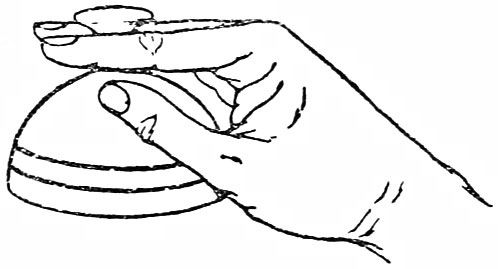
Instead of three balls the performer has four. One of these he conceals in the palm of the hand by which he lifts the cup. The handle of the cup can be grasped[19] between the outstretched fingers—(first and second)—and the ball is securely held by the muscle at the ball of the thumb. By bending the first and second fingers that hold the cup, its lip is brought in close proximity to the secreted ball. By a sharp or jerky movement forward to place the cup on the ground, and at the same time releasing the muscle of the ball of the thumb, the woollen ball naturally finds its place under the cup and the deception is complete. The performer then picks up one of the three exposed balls and pretends to place it in his bag or into the other hand. A blow on the "bean" and[20] Hey! Presto! the ball appears under the cup that a moment ago was placed apparently empty on the ground.
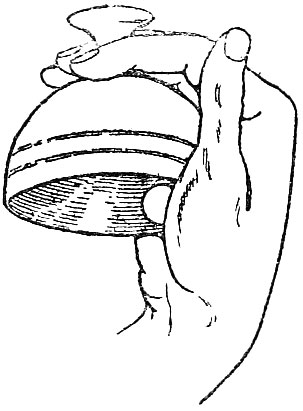
I will not go any further into the combinations and permutations, which are unlimited, of the trick. Once a person has mastered the easy dexterity described above to get the ball into the cup, he can devise further developments for himself. The diagrams given will, I trust, clear up any misunderstanding that may be left after reading my explanation. If there is still any uncertainty, for a few annas or pence, any itinerant conjuror will show the[21] sleight, and ten minutes practice ought to bring matters to a satisfactory conclusion.
This may be a fitting opportunity to disabuse the minds of some about the amount of practice undertaken by a really first-class performer. I consider that a man who is an expert needs no practice at all. Sleight-of-hand to him is just as innate as hitting any shaped ball with any shaped stick, is to a man with an eye for games. The artists who drew these illustrations, draw anything instinctively. Years of practice will never make the faces of a pretty girl that I draw look less like an amphibious cow. But I have frequently given performances of two hour's duration without any previous practice whatever, beyond a quick rehearsal to see that all the various properties are in their correct places, ready at hand when wanted. I do not want[22] the person who wishes to do a few tricks like the cups and balls, and those which I will describe later, to be discouraged under the impression that not being a born conjuror it will be useless for him to attempt small tricks without constant and monotonous practice. A little attention and trouble will make him "hot stuff" with the cups and balls and will lead him on to higher things.
CHAPTER III
THE BAMBOO-STICKS
We have now the second trick that is usually shewn by the Jadoo-wallah, that of the bamboo sticks, essentially one of purely Indian origin.
The performer takes two small bamboo sticks which have threaded through them a piece of string at each end of which is a bead. He holds these sticks together and when he pulls one bead the other is naturally drawn into its stick. He now takes a knife and passes it between the sticks ostensibly cutting the string between them. He again pulls one bead and wonderful to relate the other bead is still drawn in towards its stick, as before. He[24] now separates the sticks and holds them in the shape of a "V," and one can see that there is no string between the sticks. Still the same thing happens. When he pulls one bead the other is drawn into its stick.
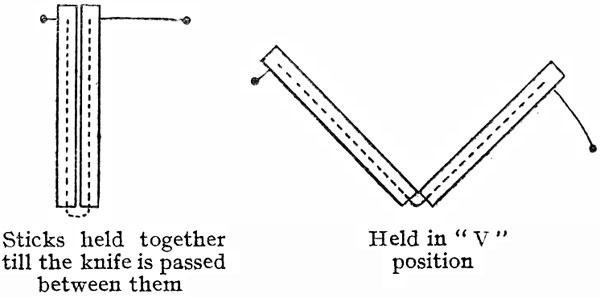
This little trick is usually sold as one of a box of tricks for children at any of the toy shops in England. The explanation is given in the diagrams below, which show that the string does not pass directly through each stick, but from one side only, then through its centre down to the bottom, across to the other stick, up through its centre, and out through its side. Consequently[25] passing the knife between the sticks cannot harm the string in any way.
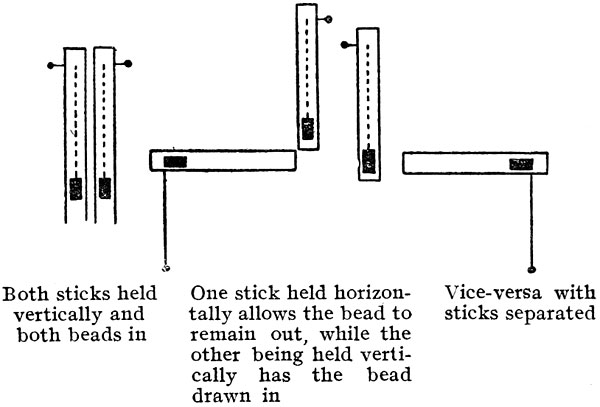
The Indian conjuror goes still farther than the trick as supplied in the child's box of tricks. After pulling the string to and fro while the sticks are held as a "V" he separates the sticks completely. The same result occurs nevertheless. When he pulls one end of the string the other end is drawn towards its stick. This is brought about by a different construction of the apparatus than that described above.
In this case the string is put through one side of the stick and is attached to a small weight that can move freely up and down the hollowed out centre of the bamboo. When the stick is held vertically the weight will drop and the bead attached to the visible end of the string will be automatically drawn in. When the performer wishes to leave the pulled string out, he must incline the stick to a horizontal[26] position when the weight will not slide down. The diagrams will show how the sticks should be held while showing the trick. It can be easily manufactured or bought in a bazaar for a few annas.
THE RING ON THE STICK
The sticks are put away into the basket, and the magic wand is produced for our next little experiment, that of putting a borrowed ring on to the middle of a stick that is held at both ends. Almost every[27] European in India has seen this performed in India for it is the favourite of the Jadoo-wallah, and is the most effective of the small tricks that he can show. It takes up a considerable time and is simplicity itself.
In case any of my readers have not seen the trick in India, or on their way out at Port Said, I will describe it. The performer either borrows or uses his own thin cane, and passes it round to his audience to show that it is devoid of all mechanism. He then borrows a wedding ring, which he also allows to be freely examined. He gets A and B, two of his audience, to hold the ends of the stick each by one hand. He then boldly proclaims that he proposes to pass the ring on to the middle of the stick without either A or B letting go of their respective ends. In order, however, not to divulge the secret he must pass it on under cover[28] of a handkerchief. He takes the borrowed ring and wraps it up in the middle of the handkerchief which he asks some one to hold, and to feel the ring wrapped up in it. In order to let everyone know that the ring is really there, he takes the stick from A and B and gives a tap on the ring. He then gets A and B to hold the stick once more and persuades C, who is assisting with the handkerchief, to hold it over the middle of the stick. The performer holds the corner of the handkerchief and instructs C to let go his hold on the word "three." "One! two! three!" The handkerchief is sharply pulled away and the borrowed ring is seen to be spinning on the middle of the stick!
This is how it is done. The stick is an ordinary one, thin enough to pass easily through a wedding ring. The only prepared article is the handkerchief, in one corner of which is a duplicate wedding [29]ring sewn into a small pocket. It does not matter whether or no it is exactly similar to the ring that is borrowed, as the performer takes care that the owner of the borrowed ring does not get a chance of feeling the duplicate even through the folds of the handkerchief. When the performer takes the borrowed ring to fold in the handkerchief, he folds the one that is already sewn in it, and secretes the borrowed ring in his hand. He takes the stick from A and B to tap on the ring folded in the handkerchief, really to slide the borrowed ring into the middle of it. He hands the stick back to be held by A and B but keeps his hand over the ring now on it, thus concealing it until it is covered by the handkerchief. When the handkerchief is pulled away on the word "three" it takes with it the ring sewn into its corner and as it brushes the stick it makes the borrowed ring on the stick[30] revolve apparently as if it had just arrived in that position.
For simplicity's sake let us take the various moves as they occur.
A. Borrow a stick and hand it round for examination.
B. Get A and B to hold it at the ends.
C. Borrow a wedding ring.
D. Take the handkerchief from the pocket. (The duplicate ring sewn in the corner being held preferably in the right hand.)
E. Pretend to wrap up the borrowed ring in the handkerchief, in reality wrapping up the corner ring, and secrete the borrowed ring in the right hand.
F. Take the stick from A and B and tap the folded ring with it, now being held by C. While doing so, slip the borrowed ring into the middle of the stick.
G. Hand the stick back to A and B but keep the hand on the stick over the ring.
H. Get C to cover this hand with the handkerchief, holding the ring over the middle of the stick and instruct him to let go on the word "three."
A neat little trick that can be performed by anybody who takes the trouble to practice it a couple of times.
CHAPTER IV
THE GLASS BOX
The Glass Box and Ball.
The next trick presented to us is usually the glass box and woollen ball. The performer takes a very badly constructed glass box through which one can see in any direction. He covers this with a handkerchief and places it on the ground. Having played his "bean" for some moments he takes up the box. There is a loud click, and snatching away the handkerchief the Jadoo-wallah shows the box filled with a variegated cloth ball. He opens the lid, takes the ball out, and after casually showing it to the audience thrusts it into his bag. He is inordinately proud[33] of this effort, as he assures one that it is from "Bilayat" (England), a slander that is at once discountenanced by a glimpse at the box, obviously made by the most indifferent "teen banane wallah" (tinsmith) that ever had the impertinence to undertake to make anything.

The construction of the box is shewn in the diagram below. Its sides are of glass but the top and bottom are of tin. Before presenting the trick a cloth ball, made of a spiral spring covered with cloth, (triangular pieces of different colours sewn together), is compressed and placed between[34] the bottom of the box and a glass flap which is pressed down over it until caught by a pin at the back of the box. When the ball is to appear, this pin is pressed and the catch releases the glass flap. The spring in the ball forces it up against one of the sides while the ball fills the box and holds the flap up.

It is a most futile trick with little effect and usually uncommonly badly shewn. But the man of mystery himself is delighted with it and thinks it is the best trick in his repertoire.
The Bunder Boat.
Our next trick—so called because the toy boat used is intended to be a miniature of the harbour or "bander" boat used in Bombay—is a trick which depends entirely on natural principles, and only needs a careful eye to time its required patter. It is a trick that is more commonly shewn in the Bombay districts than elsewhere, though there is no reason why it should not have travelled throughout India since its invention countless years ago.
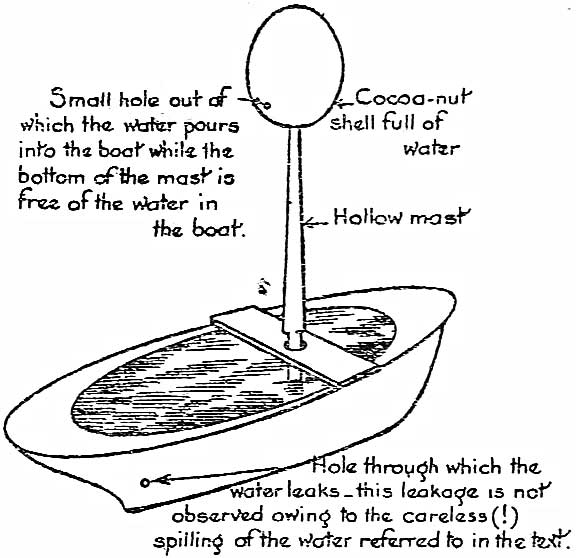
A piece of wood cut into the shape of a boat is placed on the ground, and a mast about 12 inches high is fixed into its one and only seat by being firmly pressed into the hole cut through the seat. To the top of the mast is affixed a cocoa-nut shell which has a small hole cut into it about one third of the way up. Prior to the fixing of the mast and the shell, the boat[36] and the shell are filled with water. The bottom of the mast—which is hollowed down its centre—just touches the top of the water in the boat. While filling the articles with water the performer carelessly—very carelessly—spills some on the ground all round the boat. He then blows his "bean." After a short interval he orders water to pour out of the hole in the shell. It does so until he tells it to stop. He again blows his "bean." Again[37] he orders the water to pour out of the shell. Again it pours out until told to stop. And so on until the shell is quite empty and the trick is at an end.
Wonderful isn't it? Marvellous! Mahatmaism!
Now let us have the explanation.
The cocoa-nut shell is full of water. It has only one outlet, the small hole in its side. This is so small that the air cannot get in to let the water out. The only way the air can get in is up the hollowed mast, the bottom of which is immersed in the water in the boat. There is a small hole in the bottom of the boat through which the water in it leaks away. This lowers the water until it has cleared from the bottom of the mast through which a puff of air goes up into the shell, allowing some of the water in the shell to pour out into the water in the boat. Now the water from the shell pours out in greater volume[38] into the boat than the water that is leaking out of the boat. This fills it up again until the bottom of the mast is again immersed, stopping any air going up into the shell and the water stops pouring out of it.
The performer drones away on his musical instrument until he sees that the water level in the boat is just about to clear the bottom of the mast. He then orders the water to come out of the shell. He watches until the newly added water to that in the boat is about to cover the bottom of the mast again, and then gives that wonderful and much used order "Bus" that, possibly, many of my readers may use from time to time after the sun has set. The water stops pouring out of the mast.
Wonderful isn't it? Mahatma. Ghandi ki Jai!
CHAPTER V
THE BOWL OF RICE
A surprising little trick was once shewn to me by a performer whose exhibition of magic was otherwise of a very low class.
He borrowed a "lota" or brass water bowl of one of the servants. These lotas are invariably so shaped that the circumference of the top is about half that of the widest part, thus:—
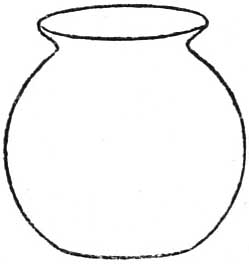
He then borrowed some uncooked rice with which he proceeded to fill the bowl to its utmost capacity. While doing so[40] he kept on bumping the bowl on the ground so that the rice was packed as closely as possible inside it, until finally one could see the last few grains in a pyramid on top.
He then borrowed a large table knife, and as it were, stabbed it into the rice down into the bowl. Little stabs at first, and then deeper and deeper until the whole of the blade of the knife was in the rice, and the handle alone remained to be seen. After an incantation and jadoo-music, he caught hold of the handle and raised the bowl and the rice slowly into space. He then swung it to and fro and eventually spun round and round, holding the handle of the knife while the bowl and its contents of rice clung tenaciously to the blade. Beginning to slow down, he at last replaced the bowl on the ground, extracted the knife and handed it to me for examination. He emptied the bowl pouring the rice into[41] some paper laid out to receive it. The closest scrutiny revealed no trace of "gadgets" or of any artifice that had enabled him to thus lift the filled bowl.
A small bribe could not tempt him to reveal the secret, and in such cases I make it a rule to try the trick exactly as I have seen it done.
I took a similar bowl, filled it with rice, and stabbed it with a table knife. Gently at first and then more firmly. To my astonishment I found that after three or four stabs in exactly the same place, the rice below the blade seemed to get harder, until I pressed down the knife and found that I could not extract it with a straight pull! I lifted the bowl of rice, and could with impunity swing it round over my head just as one uses an Indian club. To extract the knife one has to twist the handle slightly, when it comes out immediately. Try it and see.
The Coloured Sands.
Occasionally our conjuring friend breaks out from the stereotyped programme already described, and one of the most common additions to his programme is the "coloured sand" trick.
He has a bowl of water on the ground, and from a number of small packets of paper he takes a corresponding number of different coloured powders. Let us say "Green, Red, White, Orange and Blue." He pours all these into the bowl of water, which assumes a dirty blue colour when stirred up well.
Finally, from a box containing common sand he puts two or three handsfull into the basin of water and thoroughly mixes up the contents of the bowl.
He then asks his audience which coloured sand they would like extracted from the water. The reply may be "green." "Wet or dry?" asks the conjuror. Let[43] us ask for "dry." He dips his hand into the water and grasping, apparently, a handful of the mixture, draws it out again, and squeezes out a shower of dry green sand, unmixed with any other colour! "Now what colour will you have?" asks the magician. Let us ask for "wet blue sand." He dips his empty hand into the water, and draws out a handful of wet blue sand, for, when he opens his hand, a damp ball of blue sand falls on to the ground. He can deal with the other coloured sands in the same way, bringing out each colour separately, and wet or dry as desired.
How on earth is it done?
The different coloured sands or powders are put into the water in a fair and square manner. But the solution of the trick is to be found in the way in which he puts the common sand into the water. This common sand is kept in a box, and in it are little balls of prepared powders or sand[44] of colours corresponding to those already put into the water. These balls are prepared by being mixed with a little water, rolled into a ball, which is smeared all over with grease, and then baked until dry. Each ball can then be immersed in water for a minute or so without crumbling or being damaged by the water. These balls are put into the common sand box, so that they are only just visible to the performer. He puts his hand into the box and extracts a handful of common sand, together with a ball of powder. He thrusts his hand into the bowl leaving the ball immersed, and notes its position. He again takes a handful of common sand and with it another ball which he places in the water. Similarly he places all the coloured balls into the water, under the guise of adding plenty of common sand, to make the trick more difficult and wonderful. He notes very carefully the[45] position of each coloured ball as he puts it into the water, as when immersed they cannot be seen either by him or the audience, owing to the dirty blue-ishness of the whole mixture.
The audience now select the colour of the powder to be extracted. The performer remembers the position of the required ball and takes it out.
If it is to be poured out wet, he opens his hand and drops it on to the ground. If it is wanted "Dry," by squeezing the ball, its baked shell is cracked and its contents pour out.
There is no difficulty in performing the trick. It is very effective and one that is included in the programme of many European conjurors, though their modus operandi is more efficient and needs less preparation.
CHAPTER VI
A ROPE TRICK
The only rope trick I have ever seen performed by an Indian conjuror, is that of "The cut string restored," as it is called in England.
The idea is to get one of the audience to cut a piece of string or rope ostensibly in half and by magic to restore it, without the use of knots.
The explanation of this trick is given in many books for beginners in Magic. The author of "Modern Magic"—the best work to my mind on Elementary conjuring—says of it "This trick is of such venerable antiquity, that we should not have ventured to allude to it, were it not [47]that the mode of working, which we are about to describe, though old in principle is new in detail and much superior in neatness to the generally known methods."
After offering the rope for thorough examination Shah Mahommed took the two ends and manipulated the rope in such a manner that when it was held out to be cut it was in this wise:—

Held at A by the left hand and at B by the right. It was cut at x and consequently was in two pieces not of equal length, but of which one was practically the whole length of the rope while the other was the piece AX, or possibly some six[48] inches long. While gathering up the rope to be magically restored, the old scoundrel simply got rid of this small piece and showed the longer one as the restored rope.
To go into details and to give the "drill" as to how to get the string or rope into the required position would be tedious and difficult to understand. The illustration, I trust, explains sufficiently clearly the secret of the trick, and if one tries to get it into this position it will be found quite easy to do, "chacun à son gout."
Shah Mahommed made quite a feature of the trick, using two assistants for it, one to hold the rope occasionally and the other to cut it.
The first time I remember seeing it was when Uncle George showed it to me on my fourth birthday, many long weary years ago.[49]
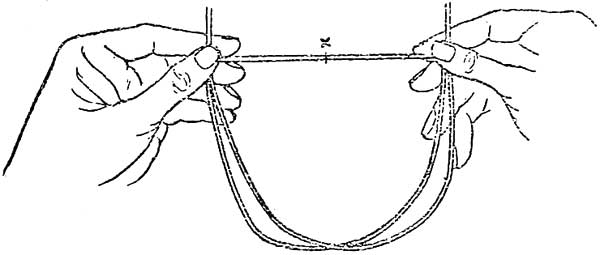
The string (as shewn in the above illustration) being held for the audience to cut at x.
THE SWASTIKA
I remember on one occasion some 20 years ago, being very puzzled by a trick that is often performed in Bengal.
The magician gets from one of the servants a broken "chatti" or earthenware bowl. He selects a piece about two inches square and asks one of his audience to draw upon it with a piece of charcoal, borrowed from the "Khansamah" or[50] cook, the sign of the Swastika, with which most people are familiar.
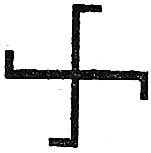
The draftsman is then requested to place the piece of earthenware or tile on the ground and after gazing intently at the Swastika to crush it to powder with the heel of his boot. These instructions are accordingly carried out. The man of magic now asks his assistant to look at the palm of his hand and see that there is no mark upon it. There is no mark. The hand is then held out palm upwards over the powdered tile and the assistant is told to gaze at it intently. After a few seconds the performer turns the assistant's hand over so that it is now palm downwards. A little music on the "bean," a magic pass, a mystic word, and the assistant is requested[51] to look at the palm of his hand, when to his astonishment, there is a distinct mark of the Swastika upon it! Truly a miracle!
The trick is a most effective one, and when well performed, with intervals for gazing at the dust, the clean palm, mystic words and so forth, it would baffle most audiences. Yet it is simplicity itself, and this is the secret.
When the Swastika is drawn on the piece of tile, the performer in placing it on the ground to be trodden upon, puts his thumb on the drawing, and thereby gets an inverse print of it on the ball of his thumb. The tile is powdered and the hand held palm upwards over it. When turning the assistant's hand palm downwards, the conjuror does so with his fingers at the back of the assistant's hand and the thumb on the clean palm, leaving the imprint of the Swastika upon it. A rub with his thumb on his garment, or the[52] ground, removes instantly all trace of the medium between the tile and the assistant's palm. Charcoal must be used as it is soft to write with and gives the best imprints. An "HH" pencil for instance, might do, but the imprint would be hardly visible on the palm.
I consider this little trick to be one of the most mystifying of the Indian conjuror.
THE EGG BAG
An effective little trick usually follows that of the Cut and Restored String in the form of an egg being put into a small bag. A magic pass is made over the mouth of the bag, which is then turned inside out, stamped upon if necessary, and slapped all over to show that it is quite empty and that the egg has disappeared. At will, and with another magic pass, the egg reappears from the bag when it is turned over, mouth downwards.
The secret lies in the fact that the bag, which is of some opaque material, and is nine inches deep and six inches broad, has one of its sides double. The easiest way to make such a bag is to take a piece of cloth six inches broad and 24 inches long. Fold six inches of one end over and then turn the other end to where the cloth has been folded. Stitch up either side, thus making a bag.
When the egg is put in, it drops to the bottom of the bag. When the performer dips his hand in again to take out the egg, in doing so he slips it into the pocket formed inside, and leaves it there, bringing his hand out empty and from which the egg has disappeared. The bag being turned inside out does not expose the egg which is in the inner pocket. When treading on or slapping the bag, care should of course be taken to miss the egg.
CHAPTER VII
THE DANCING DUCK
As his last trick was with water the Jadoo-wallah sensibly enough proceeds to show another with water, though an English conjuror would separate such tricks from an artistic point of view, thinking that a change of diet in magic is just as necessary as it is in a meal. The trick is that of the dancing duck.
A half cocoa-nut shell is dug out of the bag. It is wrapped up in a piece of cloth and very carefully unfolded, for reasons that will be apparent later. In this shell is a little wooden duck. The shell is placed on the ground and filled with water upon which the duck floats. The performer takes his "tom tom" and while playing [55]it the duck begins to dance, as it were, upon the water. After an interval it is commanded to pay its obeisances or in other words, to "salaam," which it does by going right under water. On the word "bas" it comes up again. And so forth and so on.
It is a clever little trick and we will now see how it is done.
The cocoa-nut shell has a hole through the bottom of it. Through this hole passes a horse hair that is attached at one end to the duck and at the other to a piece of bees wax. The hair is about two feet long. The whole apparatus is wrapped in a piece of cloth as otherwise the horse hair would get unwound and broken. When placing it on the ground, the bees wax enables the performer to see where the end of the hair is when unwound. The shell is filled with water, some being carelessly spilt to prevent[56] the leakage through the little hole at the bottom being too noticeable. When picking up his "tom-tom" the performer also picks up the bees wax, and attaching it to the "tom-tom" the arrangements are complete. Bringing the "tom-tom" closer to the body makes the duck dive under water. The ordinary shaking of the drum makes the duck dance.
This is not a trick that can be conveniently shewn by Europeans, because of the inconvenience of doing it on the ground. The leakage of the water is not so apparent on the earth, which hides the horse hair. But at a small distance the trick can be done on a table, as the horse hair is quite invisible at a range of five feet, especially when it is against a dark back ground. It can be easily made or bought for a few annas, and with good patter presents a neat little after dinner experiment.
The Mango Tree Trick.
To my mind it is amazing what a spurious reputation this trick has gained. From a technical point of view, it is possibly the worst performance of the Indian conjuror. From a physiological point of view the gullibility of the audience is astounding. Wherever one goes in England, France or America, in fact anywhere out of India, and the conversation turns to Magic, one is asked about the Mango Tree trick, and whether one has seen it done. I have heard the most gorgeously elaborated descriptions of this trick, given not only by persons who had heard about it but, I regret to say, by persons who said that they had seen it done. On one occasion on board ship a Eurasian, who hailed from —— and indulged in the Mahommedan name of Macpherson, gave me the following details of the trick as he had seen it performed, of course[58] many many years ago. When he was only two years old I expect.
"A conjuror came into the compound, and my father told him to clear out. The man, however, persisted in remaining, saying that he had something very wonderful to show us. My father eventually agreed to watch the performance. We all sat down on the verandah, which was of solid concrete, and the Jadoo-wallah took off his "dhoti" or loin cloth, and squatted in front of us. He produced a mango stone and put it under some loose earth, which he had gathered up from our own garden. He played on his flute, and as he did so the stone began to sprout until the little shrub was about two inches high. He then watered it a little and again began playing the most beautiful music to it. The little plant grew higher and higher as he did so, until it was quite two feet high with a number of leaves upon[59] it. He then watered it a second time, and again played his flute until the tree was four feet high with fruit on it. He then stopped his music and cut one of the mangoes off the tree, which my father ate and found to be delicious."
That was Macpherson's story.
I have never seen the trick done this way, and do not know of anyone who has. But I have an explanation to give. In fact four explanations. These are:—
That Macpherson and Baron Münchausen were relations.
That Macpherson's cousin was Louis de Rougement.
That the trick as above was explained to me late at night, after Macpherson had had "one or two."
That it was never done at all. Of course I do not want to call Macpherson a liar. It would be rude. He is a bigger man than I am, and he might meet me again.[60]
I will now describe the mango trick as I have seen it performed many many times.
The Jadoo-wallah, sitting under the porch and not upon a concrete verandah, heaps up some earth in front of him. He wets this until it has the consistency of mud. He then places in this little mound a mango stone and covers the whole with a cloth. He plays the "bean" and takes away the cloth when the heap is found to be as before. He takes the lid of his basket, and covering it with the cloth, places it over the heap of mud propping up one end of it, that towards himself, with a little piece of stick. More "bean." He then takes away the lid and cloth. Still no result. He puts back the covering again. (I am going to call this point "A" for my explanation.) After a certain amount of manipulation, during which is heard the rustling of leaves, he lifts it up and Lo! [61]and behold! there is a small plant in view. He administers to it with water and adjusts its leaves. He again goes through the same performance as above. Each time that he takes away the basket cover the tree has grown larger. The most developed finale that I have seen, is when the tree was about two feet high with a number of leaves and two diminutive unripe mangoes on it.
My explanation will rob those who like to imagine that magic pure and simple, accounts for the Mango Tree trick of a great deal of their enjoyment in that belief.
The making of the loose earth into a mud pie is necessary, because, otherwise the bits of branches that are to be stuck into it from time to time will not stand upright.
At the point "A" referred to above, when the performer takes the basket lid away, with the cloth he picks up a small[62] bundle by his side which contains a small piece of a mango twig with two or three leaves upon it. Under cover of the replaced lid he undoes the bundle, gets out the twig, and sticks it into the mud heap pressing it firmly down, so that it stands erect and appears to have grown there. He plays a little music and carries away the lid, and with it the empty rag that contained the twig. He places the lid on the ground and so gets rid of the rag. While his audience are showing their surprise at the development of the twig, he picks up still another larger bundle containing a still bigger branch of a mango tree. He replaces the lid, and under cover of it unfolds the bundle, gets out the branch, adds it to the twig already in the mud heap and makes all secure by again pressing down the mud.
Finally he plants in the same way, the branch which has possibly two mangoes [63]upon it. It might even have ripe fruit, the means of getting them there being just the same, though the ripe fruit being brought to view will of course depend upon the season of the year at which the trick is being shewn.
When the necessary monetary subscription that follows this trick has been completed, the Jadoo-wallah sweeps the branches, earth, and all away in one fell destructive swoop which does not allow his audience to ascertain whether or no the tree had any roots.
Occasionally, instead of the basket lid, the magician uses three sticks tied together in the form of a tripod over which he places his cloth under which he works his mysteries. This was the method of Ghaus Mahommed.
Many of my readers may say that the above cannot be the explanation of the trick. All I can say is, that the next time[64] they see the mango trick being performed, let them take a copy of this little book and refer to it as the trick progresses, when I feel confident that they will accept this true and only explanation.
If they are still unbelievers, or rather believers in the real Magic of the trick, let them offer untold gold to any man who will do the Mango Tree trick in India in January, or February, culminating in the tree having ripe or unripe fruit upon it. As far as I know, the Mango Tree does not give fruit in these two months and the money will never be forfeited.
Now that we know the explanation, does it not strike the reader as amazing that such a crude, simple trick should have gained the reputation it has done. I can only attribute the fact to persons like our Mahommedan and Scotch friend Macpherson, who tell "traveller's yarns" until they in time begin to believe them themselves.
CHAPTER VIII
THE BASKET TRICK
When we discussed the Mango Tree trick, I commented unfavourably upon the veracity of our friend Macpherson. Let me here state definitely that there is no such person as far as I know, though the description of the trick as I have given it, was related to me word for word in the smoking room of an outward bound ship. It was capped by some one saying that they had seen the tree grown without earth, on the deck of a steamer on its way to Australia. I make no comment on this version of the Mango Tree trick. There are many people who describe tricks to me and ask how they could have been done. Some of these baffle all explanation.[66] They are so marvellous, that I am convinced that they have never been done and could never be performed.
Such tricks as described to me are usually the fruit of a vivid imagination, pure and simple. As an instance of this, I will relate an incident that happened some time ago in Calcutta. I gave a performance in a public place in which I did a billiard ball trick. In the trick, the greatest number of billiard balls that I have at any one time in my hands is two. Throughout the whole of the trick I use no more than one red, two white, and two smaller white balls. Five in all. After the performance, I was having a well earned drink, when a complete stranger to me asked if I had seen "that chap who did the tricks." I could truthfully answer "no" and did so. "He was an absolute marvel," said the stranger "there he was on the stage in evening dress with both[67] arms bared (I never bare my arms) and he produced the whole set of pool balls, every single colour of them." This was said to me within ten minutes of my having performed the trick, and the five balls that I used had been exaggerated into sixteen or seventeen. I forget how many balls are used at the game of Pool.
The French Police truthfully say that no two untrained persons can describe accurately in detail a scene witnessed an hour previously. I am sure that all our Indian judges can verify this statement. It can be easily proved by any one of my readers trying with his friends. It is this inability to accurately describe what has been seen that assists the conjuror so much in deceiving his audience. It is this inability which unfortunately results in rumours being spread of wonderful performances being given by magicians in distant lands, notably the Rope trick,[68] with which I will deal later. Such rumours and stories are started by persons who from bravado will swear that they have seen this, that, and the other, in order generally to be the centre of their astounded listeners.
A trick that is most frequently described is that known as the Basket trick, which is in my opinion the chef d'oeuvre of the Indian Jadoo-wallah. It is a wonderful bluff usually wonderfully shewn.
A perfectly good basket is placed on the ground. It is shewn to be quite empty and devoid of any trap, false bottoms or other mechanism. After a well conducted altercation with his assistant, a small boy, the performer tells him to get into the basket. The boy attempts to do so, but finds that it is too small to contain more than his feet and legs doubled up. The Jadoo-wallah presses forward the little boy's head and this leaves only[69] his shoulders and back visible. A large cloth of thick texture is then thrown over the little boy who is half in and half out of the basket, and the lid is balanced on top of all. A little more altercation ensues when the Maestro takes a big stick and aims a mighty blow at the basket. As the blow falls the lid sinks down on to the top of the basket, and a terrible silence is the result.
The Jadoo-wallah realises that he has killed his assistant, and, if a good showman, bewails his lot suitably. He then decides to get rid of the body and, in some cases, to restore it to life again. In order to show that a tune on the "bean" has the required effect of making the body disappear, he lifts the lid of the basket and first with one foot and then the other steps on to the cloth covering the basket and presses it down to the bottom. There is nothing in the basket![70]
To further prove the emptiness of the basket he replaces the lid, through the middle of which there is a hole, and through this hole thrusts down in all directions a sword. Occasionally he thrusts it through the sides. There is nothing in the basket. The body has disappeared.
This ends the trick, though on occasions the performer orders the lad to re-appear from the end of the garden, or elsewhere.
The collection is made, the basket is hitched up on the shoulder pole and with his bag of tricks the Jadoo-wallah moves on to the next bungalow. How can it be done?
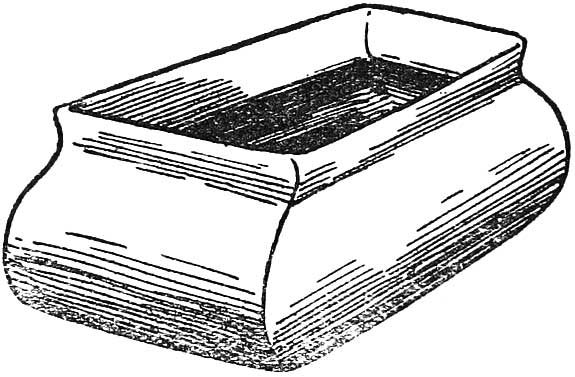
First let us note carefully the shape of[71] the basket. It is oblong, about two feet high with a bulge in all its sides, so that the bottom of the basket is larger than the top.
When the boy gets into the basket he places both feet into it and sits down, filling the basket thus:—
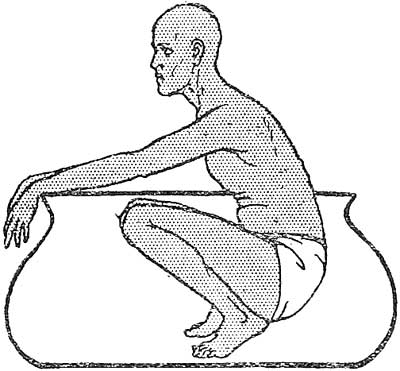
When the performer pushes his head forward the boy gets into this position:—

The cloth is then thrown over all, the boy and the basket, and while the lid is being placed on top, and the altercation continues, the boy gets into this position, holding the basket lid up with one hand.
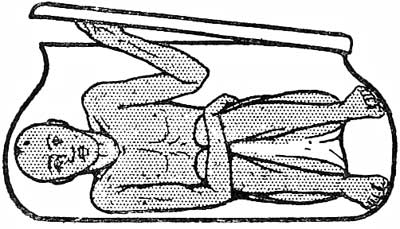
The lid of the basket being held up like this causes the audience to think that his former position is unaltered.
If one were to take away the cloth and look inside the basket one would see the boy lying something like this.
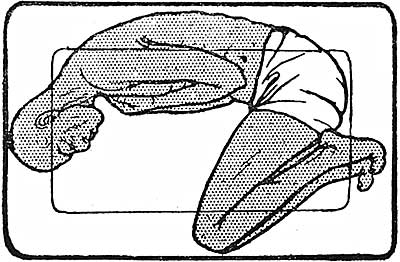
The performer takes away the lid which the boy has allowed to sink into its proper place after the terrible blow with the big stick, and to show the emptiness of the basket, puts his feet into the basket, between the body and bent up legs of the boy, and sits down on top of the assistant. By doing so he pushes the cloth down close on to the boy.
He then gets out again, replaces the lid and thrusts the sword through the hole in the lid twisting it in all directions. Were it not for the thickness of the cloth, which is by now close to the body of the boy by reason of the performer having pressed it down by sitting in the basket, the sword would certainly hurt the little chap. Incidentally the sword is none too sharp.
The sword is withdrawn and pushed through the sides, above the body of the boy.[74]
The basket is proved undeniably empty.
If my readers doubt this explanation, let them offer the Jadoo-wallah, at this stage of the game, two thousand rupees to be allowed to fire a No. 8 cartridge from a 12 bore gun from a range of thirty yards at the empty basket. The performer will not accept the offer unless he values the boy at less than two thousand rupees and has a good chance of escaping arrest for murder. I have offered it twice with impunity.
The trick divides into two endings. One can always tell which ending it will have by a glance at the basket. If it has two ropes which pass underneath it, permanently attached, the betting is that the boy will appear from the end of the garden. The reason of this is that after the re-appearance of the boy—a duplicate of the one in the basket—the permanent ropes on the basket allow it to be hitched[75] up on the shoulder pole and carried away, with the disappeared boy still inside it. When the Jadoo-wallah gets round the corner, the little assistant gets out while his impersonator goes a round about way into the next compound ready to re-appear at the end of the next performance of the trick.
If the basket has no ropes attached to it, odds are on the performance ending by the magician apologising profusely to his Gods who restore the boy from the depths of the basket again. The performer in this case has no duplicate, and the trick if well presented is almost as effective as the other, with the more elaborate ending.
CHAPTER IX
THE INDIAN ROPE TRICK
We have now gone through the average performance of the Indian Jadoo-wallah and have, I trust, some idea at any rate of how his tricks are done. Though this is as far as I know the first time that such explanations have been published in detail I do not want anyone to accuse me of trying to deprive the poor fellow of his means of livelihood, which is far from my intention. In fact, though people who have read these pages have a glimmering of how he does his tricks, few of these will be able to imitate them, and those who are really interested will probably call in the next Jadoo-wallah that appears, to get him to give his show with the intention[77] of checking my explanations while the tricks are being performed. I sincerely trust that this will be the case as I shall have done at least one Jadoo-wallah a good turn.
It is true that conjurors have a code of honour—this may not be believed of such deceptive people—in that they do not divulge each others tricks which are performed exclusively. For instance, suppose that Mr. A invented a new trick and showed it to Mr. B, who is also a finished artist. Though Mr. B could see the modus operandi of the trick he would be quite unjustified in giving it away or in doing the trick himself without the permission of Mr. A. This is an inviolate law of Members of the Magic Circle and applies equally, or should do, to showmen who do not belong to the circle.
There is no harm, however, in one of us explaining tricks that have been performed[78] for centuries and are almost common property. These tricks have lost, as it were, their patent rights. Personally, I do not mind explaining any tricks of my own that I am certain an unskilled person could never possibly do.
Having completed the average programme of our Jadoo-wallah, I feel sure that people will say to each other "Yes" but what about the Rope trick? He cannot explain that and has avoided the best known trick of all Indian conjuring tricks.
In self-defence therefore, we will deal with the Great Rope trick. I will describe it as it has been described to me.
The performer, in one's own compound, throws up the end of an ordinary rope into the air. By some mysterious means this end remains suspended in mid-air, without any visible means of support, so much so that the little boy assistant[79] climbs up the rope to its very highest point, whence, after an interval, he entirely disappears. The performer then takes a sword and waves it in the air, when the legs and arms, disjointed, and finally the trunk and head of the little boy fall with a profusion of blood upon the ground at the foot of the rope. By means of an incantation these resume their natural positions, and the little boy gets up and walks off, apparently none the worse for his most trying ordeal.
This trick was first described in writing by one IBN BATUTA, an Arab, who made a journey round the world about the year 1368. (I am not quite sure of this date). As far as I remember he saw it in China. He gives the most blood curdling description of the trick, and ends up with "so much so that we had to have another drink." Please note the expression "another drink." I am of opinion that[80] "this other little drink" did all the harm.
Missionaries have from time to time stated that they have seen this trick performed, though in no instance do they give the place or the name of the wonderful man who did it.
Although I have been most anxious to see the trick for the last twenty-three years, during which period I would gladly have travelled from one end of India to the other to do so, I have never yet met anyone who has definitely told me that he with his own eyes had seen the trick. There is one exception to this statement, an Irish bandmaster of a Gurkha regiment, who was I think, trying to pull my leg.
I have met innumerable people whose aunt's sister's cousin saw it done, but never have I had the pleasure of meeting anyone directly deceived by it.
A reward of a year's pay has been open to every sepoy (or Indian soldier) I have[81] met, who has seen the trick and can give me the name and residence of the performer. This for 23 years. So far there have been no acceptances.
Eminent conjurors have travelled throughout India on purpose to get into touch with any man who does the trick, but their travels have been in vain. Large rewards have been offered for such a meeting, and larger still for the performance of the trick. One single performance only, not the exposition of it. These rewards have never been claimed. The late Mr. Charles Bertram was one of these eminent men, and though he travelled twice throughout India, he returned to England without having been shewn the trick.
In 1918, Captain Holmes, V.C., gave a lecture on this illusion before the members of the Magic Circle at Anderton's Hotel, Fleet Street, London, at which all the press correspondents of the leading news-[82]papers were present. He produced a snapshot of a man purporting to be showing the Rope Trick in Poona, or Kirkee, one of its suburbs. Captain Holmes explained that though the boy did climb up what he (Holmes) thought was a rope, he did not disappear at the top, nor did the disgusting exhibition of blood and disjointed limbs take place. This snapshot was carefully examined through a powerful magnifying glass, and the supposed rope had distinct joints in it similar to any bamboo pole, which Japanese jugglers use when showing the feat of balancing a pole on their chins and allowing a boy to climb to its top. A trick that most of us have seen many times in the music halls of London. At his lecture, Captain Holmes stated that he did not see the man throw the rope up into the air, as he arrived late just in time to take a photo of the boy while in the air.[83]
Many explanations have been given from time to time as to how this mythical trick has been done. The most amusing is that which was quoted at the Mass Meeting referred to above, and as far as my memory goes I will quote it here.
"The trick is performed during the heat of the day, when the sun is at its zenith. The performer gets his audience to sit in a verandah facing the most powerful glare of the sun. The rope is thrown up and the boy climbs to its topmost end. On the explosion of a gun the boy completely disappears only to re-appear from the other side of the house or garden.
The explanation is simple, on the sound of the gun, when the audience are somewhat startled, the boy jumps from the rope on to the top of the verandah up which he climbs, coming down the other side of the house and re-appears."
I make no comment on this explanation.[84] It is not worthy of one.
"It is done by mesmerism." How many times have I heard this futile remark when discussing the Rope trick. What always defeats me is this. Supposing it could be done by mesmerism, why does this wonderful mesmerist, hypnotist, or suggestionist limit his powers, marvellous as they are, to making people believe that they see a boy climb up a rope.
Why does he not make people believe that he is Mahatma Ghandi and the Ali brothers rolled into one? As the trick is done for a means of livelihood, why does he not make people see him as Dr. Barnardo asking for funds for charities. His limitations are unbounded, yet he sticks to this absurd rope and the boy climbing up it.
"Tum tua res agito paries cum proximus ardet." I do not know what this Latin quotation means, but I would like it to[85] convey "don't you think it rot yourself?"
Ask any medical man about the explanation of hypnotism and kindred other "isms" being accountable for the performance of this trick. I understand that a hypnotist can persuade a patient to believe that his finger is momentarily stiff, and that when released from this suggestion, the patient can remember that it had been made to him. But in order to persuade a person that he sees such a thing as a rope being thrown in the air and so forth, that person must be so much under the influence that when he is released from it he is totally unable to remember what he saw when under the trance. How then, can he describe what he saw when he comes to?
Some people say that photos have been taken of the trick and that when the plate was developed it was found to be blank. As I say, a person to be sufficiently mesmerised to imagine that he sees the trick[86] being done, must perforce be so much under the influence that he cannot remember what he saw or anything that he did when under that influence. How does he know that he took a photo? Or that anyone else took one? Or remember anything at all about it?
I hope that the above arguments will do away with the plea of mesmeric power being accountable for this myth. The plea is to my mind too absurd for words, yet it is wonderful that many people put it forward in all good faith.
While on the subject of photography, let me now point out that although the magicians of Europe and America have for ages been trying to get in touch with the trick, and although the ubiquitous Kodak has been in vogue for at least thirty years, not one single photo or snapshot is available that depicts any part or portion of this trick. If there is such a[87] snapshot, and its owner cares to communicate with me through my publishers, I can get him a good price for the plate or film, even for a copy of the picture. A really handsome price for it.
To sum up I maintain that the trick has never been performed out of doors. That is to say that a rope thrown up into the air has not remained suspended in mid-air, nor has any boy ever climbed up it. That when at the top he has not disappeared and that after his disappearance he did not come down in bits, covered with blood or otherwise.
I further maintain that no one has seen this trick, as described above, or in any way similar to the above description, who can come forward to give the approximate date, of such a performance, the place, and the names of the performer, his assistants, or of any two other persons who saw the trick done at that time and place.[88]
I only wish there might be such a person. We might then get in touch with the Indian Rope trick and Ibn Batuta's character might be vindicated.
I offer Rs. 5000. (£300) to anyone who will show me the Rope Trick in the open. This amount will be payable to anyone who will arrange that the trick is performed for my benefit, in my presence.
The trick must be similar to the description given by Ibn Batuta, and must be brought to a successful conclusion before the reward can be claimed. It is to be performed at a place selected by me, either in India or England.
This offer holds good for five years from the 1st January, 1922.
My address is:—
Major L. H. Branson, M.I.M.C.,
The Magic Circle,
Anderton's Hotel, Fleet Street,
London, England.
CHAPTER X
SNAKES AND CROCODILES
The best trick I have ever seen in India during my 23 years in that country, was one that was performed especially for my benefit twice before I tumbled to the way in which it was done.
We were in our own compound or garden in a military station not far from Bombay, having tea on a small lawn—green grass—of which we were inordinately proud. Suddenly we heard the chanter of the itinerant Jadoo-wallah, and as usual I called him in to ask him if he had anything new. I wanted a really wonderful trick.
"Yes Saheb" he replied "I have something really good, that few sahebs have seen before."[90]
"What is it" said I, thoroughly aroused by his earnest manner, and hoping that at last I should have an opportunity of seeing an oriental miracle worthy of the spurious reputation held by Eastern Magicians.
"It is a trick with some snakes and a crocodile" said our friend "and if the saheb will sit down with the memsaheb, and will call the orderly, I will show it now." No sooner said than done. We sat down and called Aba Nalaode, our Mabratta orderly.
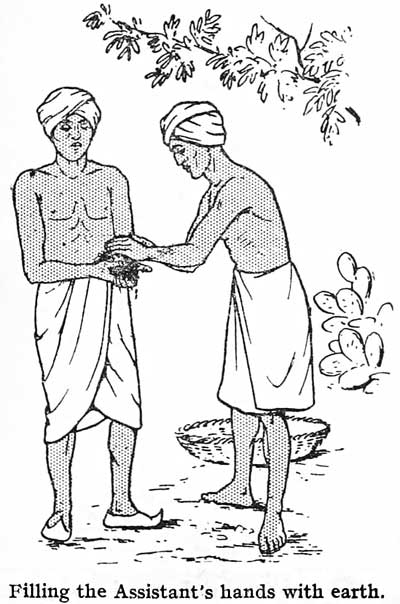
While he came from his quarters, the Jadoo-wallah proceeded to divest himself of all his clothing, with the exception of his dhotie or loin cloth. On the arrival of our orderly, he too was made to take off his shirt, leaving him dressed in a similarly negligé manner to our entertainer. The Jadoo-wallah then took some earth and made our orderly hold it in his two[91] hands held together in front of his body. He then pranced round the orderly two or three times, making, as he did so an imaginary circle round his assistant. He next called our attention to the fact that he had nothing concealed about his person.[92]
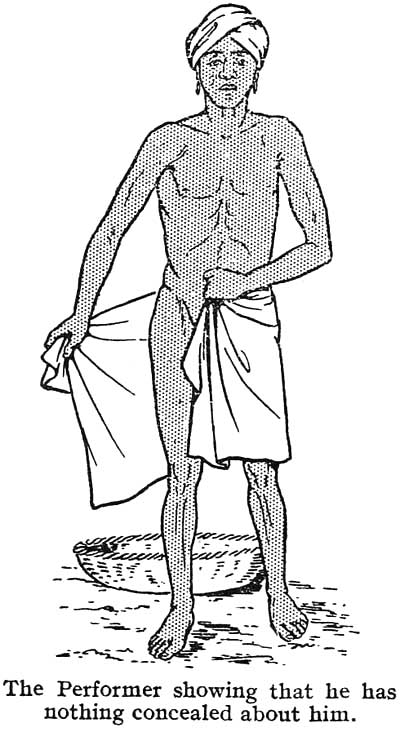
We could see that this was so as regards his bare chest, arms and waist, and to convince us that he had nothing hidden in his dhotie he showed us one bare leg at a time, avoiding barely any immodesty. Concealing our blushes, we felt satisfied[93] that his dhotie was the only worldly possession that he had with him at the moment. He picked up his chanter and continued to circle round and round our orderly, gradually closing into him. Suddenly he ran towards the outstretched[94] hands with a crouching movement and struck them a smart blow, causing the orderly to pull his parted hands away and a small cloud of dust to appear from the falling earth. The cloud faded in a moment and there, to our intense astonishment, on the ground at our retainers feet were three snakes, two of which were cobras, and a baby crocodile! Needless to say that as soon as our orderly saw these unpleasant creatures writhing at his feet he cleared off to a safe distance. The Jadoo-wallah caught the reptiles and placed them in his snake basket. I took him aside and asked him to divulge the secret of the trick.
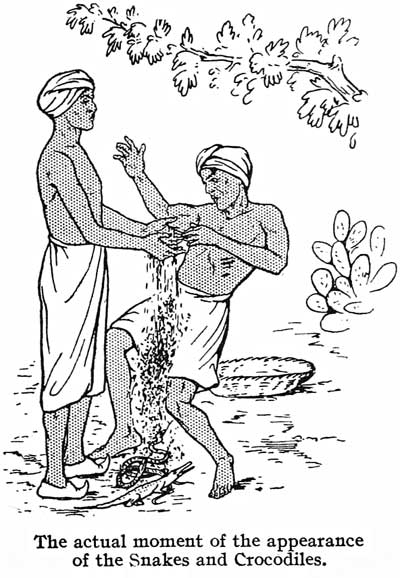
"Ha! Ha! saheb" said he "at last I have shewn you something that you do not know. I will not tell you how it is done, but will come again in a week's time and will perform it once more for your benefit."
I agreed, and after the usual remuneration[95] or bucksheesh, with a little extra, had passed hands, away went our friend down the road to the bazaar.
The following week he sent word that he was coming on a particular day, and that if I got some friends to come he would repeat the trick. The more friends, the more bucksheesh!
I gathered a few people in to have tea, and in due course the magician arrived, and with our head servant again performed the trick with the same wonderful result.
This time I solved the mystery. I told the performer my impressions of it and was glad to get his corroboration.
There was of course no collusion with the volunteer assistants.
The secret of the trick lies in a bag suspended mouth downwards from a string round the magician's waist so that it lies between his legs. This bag contained the three snakes and the small crocodile.[96] The mouth of the bag was threaded with a string, and naturally remained closed until the string was pulled right away when the weight of the wriggling contents caused the mouth to open and the reptiles to fall upon the ground beneath. The crouching position of the magician enabled him to get his legs spanning the ground immediately beneath the orderly's hands, and the earth falling in a dust prevented the possibility of our seeing the snakes during the brief interval of their falling from under the dhotie to the ground. Needless to say that the cobras had had their fangs extracted, that the third snake was harmless, and that the baby crocodile was too small to inflict any damage, though all four participants could hiss like a young steam engine.
It was, as I say, the best trick I have ever seen in India, and from a magician's artistic point of view, the beauty of it lies[97] in the fact that the bag is concealed through the modesty of the performer, and that in consequence the trick is not likely to be found out except by reasoning and the careful watching of all his movements.
CHAPTER XI
GENERALITIES, AND OTHER MYTHS.
This little book is written on Indian Conjuring, and with the exception of a dissertation upon the great Indian Rope Imagination, we have confined ourselves to tricks that we ourselves have seen, and which are common to the Indian conjuror. It would however, be incomplete without touching on one or two other broadcast myths that are frequently talked about.
Messrs. Maskelyn & Devant used to show a very clever illusion called the New Page, in which a page boy was tied up in an upright position in a cabinet just large enough to contain him. The showman then took a doll—a small model of the[99] page boy—and illustrated that whatever happened to the doll would happen to the boy in the box. As a convincing example he turned the doll upside down. Miraculous to relate, when the cabinet was opened the page boy was found to be upside down with the original knots and seals intact! This experiment according to the excellent patter of the showman, was based upon the prevalent idea that in India certain magicians make a small effigy of a person on whom some dire calamity is intended, and that whatever is done to this doll, happens to the unfortunate person at any distance, but at that identical moment. I am glad to say that I have never seen or heard of this myth being verified.
On one occasion a medical officer knowing that I was interested in Magic, told me that he was attending an idiot girl who was covered with sores and that the common[100] idea in the bazaar was that some person was working "Jadoo" upon her, using this doll method of doing so. He kindly allowed me to visit the girl with him, and, being an ordinary mortal and unused to horrible sights, I was shocked at her appearance. She had nasty open sores on her cheeks, arms and forehead. She was certainly an imbecile. Her father was adamant in his belief that "Jadoo" and nothing else accounted for her state. Her imbecility was due, we found, to her having had a fall as a baby. In order to ascertain the cause of the sores the medical officer removed her to the cantonment (Government) hospital, where after a period they yielded to treatment and were eventually cured. Evidently the "Jadoo" had ceased. On her return to her ancestral hut, these sores again appeared. With the permission of the medical officer and the parents, I employed[101] a reliable attendant to watch the girl. In three days I received the following report. The previous evening, when the girl thought that she was not being watched, the attendant saw her take something from a hiding place and rub her face with it two or three times. He watched her replace whatever it was, and later found it. He gave it to us with his report. It proved to be a piece of nut used by "Dhobies" or Indian Washermen to mark the clothing committed to their destruction-care, I should say. On every article of clothing returned by the "Dhobie" there is in one corner a small brown mark, corresponding to the stitched mark used by Laundries in England, by which the owner of the article washed is identified. This nut is called, I believe, "Areca nut." When applied to the human skin it causes a sore. The illness from which the poor girl was suffering was an "inclination to[102] maim or disfigure oneself," commonly found with imbeciles. (I have touched wood, you medical people, so please don't abuse me if I am wrong!)
As the parents were not fully convinced that "Jadoo" was not being worked, we again took the girl to hospital and again was she cured of the ghastly sores.
This is the only case of such "Jadoo" that has come to my personal knowledge.
There is another form of "Jadoo" that is believed in by the inhabitants of the bazaar. A maliciously inclined person has a spite against another. He makes a small bouquet of tomato leaves, or cabbage or some such herb, sprinkles it with salt, green powder, and so forth and so on, and lays this down as close as possible to the door of the person to whom he wants to bring bad luck for 12 months! It is true that we had this delightful bouquet thrown into our compound on one[103] occasion, and that shortly afterwards—
(1) our gardener's wife died in childbirth.
(2) my wife got hay fever.
(3) my agents declined to meet any more of my cheques until they had received a substantial instalment.
(4) we were again ordered to move to another Station.
I regret to say that of the above, 2, 3 and 4 were of such frequent occurrence that we did not assign them to the receipt of the bouquet. The gardener however, was convinced that it caused his wife to die in childbirth as she had never done so before. I have no explanation for the "denouément" and give the story as it happened, allowing my readers to judge for themselves whether or no any credence should be given to the fable after such convincing proof.

